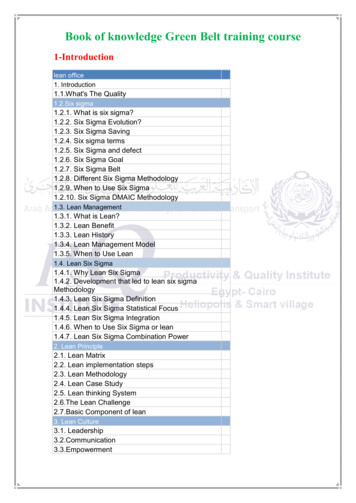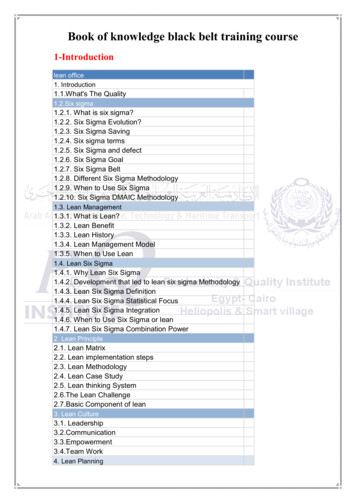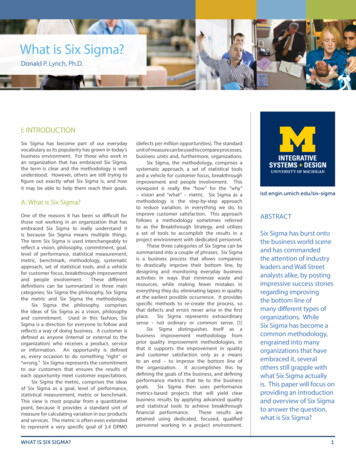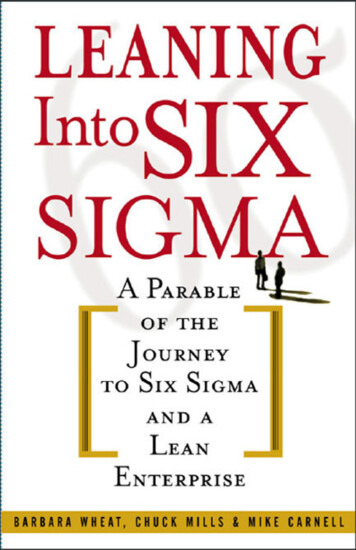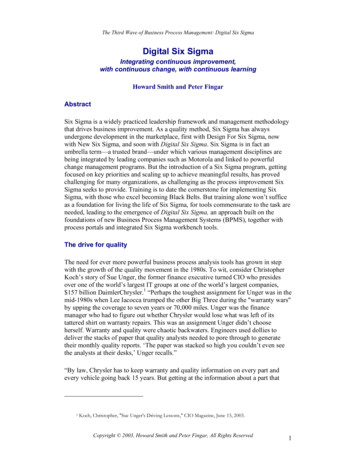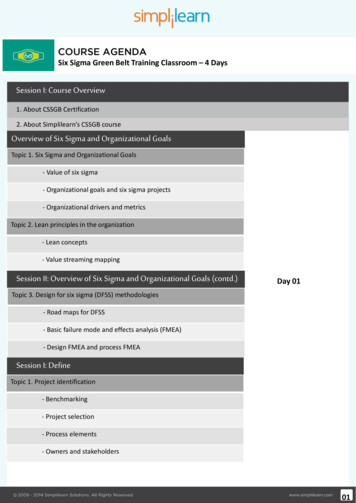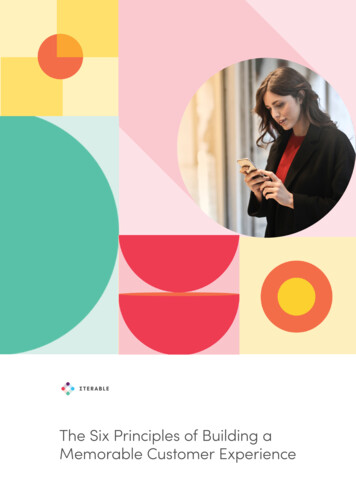
Transcription
The Six Principles of Building aMemorable Customer Experience
ContentsThe Six Principles of Building aMemorable Customer Experience3What Is a Strategic Inflection Point?And Why Does It Matter?4The Six Principles of Building aMemorable Customer Experience6Reciprocity7Liking8Social Proof9Authority10Scarcity11Consistency12Now, a Recap on Building aMemorable Customer Experience13Four Questions to Self-Assess YourBrand’s Customer Experience14About Iterable15
The Six Principles ofBuilding a MemorableCustomer ExperienceBetween a global pandemic, economic uncertainty,and social unrest, it’s safe to say that the rules ofbusiness have changed.While the events themselves aremaking a global impact, the effects on companies are not new.Unexpected change is a partof life. As former Intel CEO andfounder Andy Grove recountsin his book, Only the ParanoidSurvive:“Sometimes [business] ruleschange—often in very significantways. Yet there is no flashingsign that heralds these rulechanges. They creep up on you.without warning. You know onlythat something has changed,something big, something significant, even if it’s not entirelyclear what that something is.”Not only is it stressful for abrand internally to experiencethis shift in rules, but it alsoaffects how the entire companydelivers a memorable customerexperience.That’s why it’s important tofocus on building one usinghuman-centered principles thatwill always be relevant, regardless of current events.Once you read this guide,you’ll find: What a strategic inflection point is(and why it matters) The six principles of building amemorable customer experience A customer experience assessmentworksheet to identify strengths andweaknessesLet’s get started.3
What Is a StrategicInflection Point?(And Why Does It Matter?)Before we dive into the specifics of what a memorablecustomer experience entails, let’s talk about the importanceof a strategic inflection point, defined as:When a change in how someelement of one’s business is conducted becomes anorder of magnitude larger than what that business isaccustomed to.things happen to your business thatdidn’t before, your business no longer responds toyour actions as it used to.THE INFLECTION POINTBusiness goes onto new heightsBusinessdeclinesOnly the Paranoid Survive by Andy Grove4
We built up a major organization practically from scratch toanswer the flood of phone calls. We had not been in the consumer business in any big way before. now suddenly, we didfrom one day to another and on a fairly major scale.Andy GroveFounder & Former CEO, IntelTo illustrate what a strategic inflection point is, Grove recountshis personal experience of managing Intel through the “Bug inthe Pentium processor” crisisthat ended with the companytaking a 475 million hit to theirbusiness.Though Grove doesn’t say soexplicitly, this instance in Intel’shistory transformed its entirecustomer experience permanently. He writes:“We built up a major organization practically from scratch toanswer the flood of phone calls.We had not been in the consumer business in any big waybefore.now suddenly, we didfrom one day to another and ona fairly major scale.”Even though this event happened in 1994, the similaritiesbetween Intel’s strategic inflection point and what brands arecurrently navigating becauseof the COVID-19 outbreak areobvious. This is supported byour recent survey of 500 B2Cmarketers who are concernedabout the growing demand for“convenience and safety.”To complicate matters further, Google announced thatthird-party cookies will no longer be used by 2022, meaningbrands have to change to usingfirst-party and zero-party data.It’s official: Between currentevents and sweeping policychanges, brands are smack inthe middle of multiple strategicinflection points right now.So what can we do about it?And how does it impact the wayyour brand delivers its productsand services to customers?5
The Six Principles ofBuilding a MemorableCustomer Experience6Regardless of what changes in your business,one thing that always stays the same is that yourcustomers are human. They want to trust you likethey would anyone else in their life.Lucky for your brand, thereare tried-and-true persuasionprinciples that will always be apart of a memorable customerexperience, whether it’s 1994or 2021.This belief is backed up bydecades of research by professor and author Robert Cialdini.A scholar of the psychologyof influence, he discovered it’seasier to get people to see yourpoint of view if you know whatlevers to pull beforehand. As aresult, he breaks it down into sixfoundational principles of whathe calls “pre-suasion.”1.Reciprocity2. Liking3. Social Proof4. Authority5. Scarcity6. ConsistencyLet’s break each of these principles down, one by one.
1. ReciprocityReciprocity is the idea that ifcustomers feel like they “oweyou something,” they’re morelikely to, say, make a purchase.For example, Cialdini points tothe higher lifts in sales at Costcowhen samples are offered.team knows that this customertried their delivery service. As atoken of appreciation, they’reoffering 50 bonus points to theirloyalty account.But unfortunately, reciprocityisn’t always that simple. To be aseffective as possible, these “favors” need to meet two criteria: They must be meaningfuland unexpected They must be customizedto the individual personWant to incorporate theprinciple of reciprocity intoyour customer experience?Start with your loyalty/rewards program. Askyourself: “Are our rewardsmeaningful, unexpected,and customized to eachcustomer’s activity andpreferences?”Translation? If a person doesn’tdrink coffee, you’re probably notgoing to influence them with aStarbucks gift card.To see how reciprocity can playout for your brand, let’s lookat the following rewards emailfrom fast casual chain Chipotle.Thanks to technology, reciprocity is easy to apply in your customer messaging if you havepersonalized information abouttheir activity. Here, the Chipotle7Fast casual chain Chipotle rewards acustomer for trying their delivery service. Source: Really Good EmailsWhile reciprocity will always be a powerful method of influence, it must benoted that the delivery methods for meaningful experiences in 2021 are verydifferent from those used in 1994. To surprise and delight customers acrossmobile apps, email, and push, marketers need access to high quality customer data, and need to be able to activate that data in real time.Joey ColvinContent Marketing Manager, mParticle
2. LikingThe principle of liking is the ideathat customers want to do business with people they know, likeand trust.To showcase the principle ofliking, let’s analyze the followingemail from energy supply company Bulb Energy.Sounds simple, right? Yet, howdo you break down what getspeople to like you individually, letalone for a business?Lucky for us, Cialdini figured outthere are two reasons peoplemight like you: Similarities: Because welike people who are like usNote the following phrase:“you’re a climate change hero!”(obviously a compliment). Bulbmakes it easy and relatableto show just how much of animpact one user can have onclimate change, which is anexpress mission of the company.By incorporating this principleinto their email, Bulb makesusers feel like they’re part of alarger community with similarideals and goals, while simultaneously helping them feel betterabout their choices.Compliments: When someone makes a positive statement about our choicesand values8Bulb Energy uses visuals and graphsto help drive home the user’s impact.Source: Really Good EmailsWant to add the principle of liking into your brandcustomer experience? Evaluate your welcome emails.It’s never too early to compliment your customers orshowcase your similar interests and values.
3. Social ProofAccording to Cialdini, the concept of social proof is that“people think it’s appropriatefor them to believe, feel or dosomething if others, especiallycomparable others, are believing, feeling, or doing it.” Socialproof is characterized by twocomponents: Validity: Proof (like data orcase studies) that others likeand approve of the productor service in questionFeasibility: Whether theprospect in question believesit’s realistic to achieve thepromised resultsThanks to the proliferation ofpublic customer reviews, socialproof has become a crucial partof the modern day customerexperience. It’s almost impossible for a brand to sell withouttestimonials of some sort.Social proof often works bestright before the point of sale.For example, let’s see howmarketing organization appCoSchedule uses social proofto encourage passive emailsubscribers to start a free trial.Not sure where to insert social proof in your brand’s customer experience? Add customer testimonials into a promotional email or a bottom-of-the-funnel landing page.CoSchedule uses social proof to persuade prospects to sign up for a freetrial. Source: CoScheduleCoSchedule is well-known forits gated content marketingtools, like the Headline Analyzerand its prolific blog. So it makessense that the business had alot of subscribers on its list whowere just consuming content.However, some marketers maybe on the fence about payingfor a content calendar whentheir spreadsheets or GoogleCalendars are working, whichis why the testimonials frommarketers are so much morepowerful than the typical “Starta free trial” email.9
If your brand is selling a technical product or going through acrisis, apply the principle of authority by choosing an appropriate spokesperson to deliver the message in question. Forextra effect, use a video to supplement your message.4. AuthorityThe principle of authority is theDue to the hygienic nature of theidea that people listen to (andcrisis, public transportation like airare influenced by) others that aretravel came under intense scruti-believable and trustworthy. It’sny. American Airlines respondednot just about the content andwith a detailed email and videothe delivery mechanism of themessage outlining the ways inmessage—it’s also the status of thewhich the airline was adapting toperson who delivers it.take care of customers.Cialdini singles out two qualities inThe company needed someonea leader who exudes authority:with authority to deliver a practical, yet positive message to their Trustworthiness: Whetherthe person “presents information in an honest andimpartial fashion”Expertise: Whether theperson is qualified to speakabout the subject at handAuthority is essential in a customerexperience if your product or service has a highly technical component, but especially importantusers. A CEO is a natural spokesperson, and using video as themedium builds a connection withAmerican Airlines uses its CEO as aspokesperson during the COVID-19outbreak. Source: Really Good Emailsthe audience by removing theimpersonal barriers that comefrom silently reading an email. Itcreates the feel of a direct conver-during an emergency or crisis. Todemonstrate, let’s look at an emailsent during the COVID-19 outbreak from the CEO of AmericanAirlines.sation between the company andthe customer.By calling attention to these brandhighlights, you’re able to expressauthority and trustworthiness.There are several ways in which a brand can highlight its expertiseand authority. Here are just three:1.Showcase the company history: A brand’s extended history in an industryshines a light on its depth of knowledge and ability to endure changes.2.Openly feature partnerships: Sharing partnerships shows others have trustedyour brand much in the same way your customers can and should.3.Highlight any awards or accolades: These are a good indicator of a brand’sability to successfully implement tactics in noteworthy ways.Ron DodCMO & Co-Founder, Visiture10
5. ScarcityAll humans have wants, needsand desires. But that yearningexplodes if that desire is in shortsupply. At least, that’s the premise behind Cialdini’s principle ofscarcity, which raises two pointsof contention for an individual: The possibility of loss The judged value of that itemHowever, scarcity can backfirewhen used in excess. There areonly so many “limited-time offer”messages a brand can sendbefore customers tune them out.So scarcity is not only about thelimited time to access somethingbut also how much the customer“values” the product or servicebeing offered.For example, let’s look at thispromotional email from instantcamera company Polaroid.Notice how Polaroid doesn’tneed to manufacture scarcity toget the attention of a customer—the cameras are vintage, whichimplies that there aren’t many insupply to begin with. By simplydescribing the history of thecameras, the perceived valueof owning the item increasessubstantially.11Instant camera company Polaroidmanufactures scarcity by featuringvintage cameras in its Polaroid onlinestore. Source: Really Good EmailsInstead of relying on limited-time offers, brands canemploy the principle of scarcity by highlighting thelimited quantities of highly coveted products andservices in their promotional messages.
Consistency is key in how brands should approach consumers at every turn. Thinkabout how customers interact with a brand and whether or not the story and ethosof the brand carries through each interaction.For instance, subscriptions have become increasingly popular as a way to providea reliable, consistent experience over a longer period of time. Brick-and-mortarstores have also evolved during the pandemic, offering consistent shopping experiences online and offline through adoption of BOPIS.Ki-Hoon ChungIntegrated Media Team Lead, Within6. ConsistencyYou know the idiom of “practicing what you preach”? That’s theeasiest way to sum up the principle of consistency. According toCialdini:[People] want to be as consistentwith [their] existing commitments– such as the previous statementswe’ve made, stands we’ve taken,and actions performed.”In other words, we don’t want tobe accused of saying one thingbut doing another.Which is why it’s an importantpart of the customer experienceto always be asking for feedbackfrom your customers. If brandscan get a customer to documentin writing what they like abouttheir customer experience,the chance is high they willremember and make anotherpurchase in the future.However, the principle of consistency can show up in other formsthat we don’t expect. For example,let’s look at the following email12from CodeCamp, an after-schoolprogram for kids.Instead of simply surveying theparticipants and processing theresults internally, CodeCampgoes one step further and notifiesparents of what their particularchild said about the program. Inthis instance, the child’s customerexperience is highly positive—andwhat parent wants to deny theirchildren of something that’s educational, but also enjoyable?After-school program CodeCampsends its customer survey results tothe real decision makers—the parents.Source: Really Good EmailsApply the principle of consistency to your brand’s customer experience by regularly asking your customers for feedback. If you canget them to write something positive, the likelihood is high they’llreturn for a repeat purchase.
Now, a Recap onBuilding a MemorableCustomer ExperienceBetween the events of 2020 and sweeping policychanges, brands are currently experiencing amultitude of strategic inflection points right now.In other words? How we havedone business in the past ischanging rapidly, and most likelywon’t return to the original state.This transition is tricky to navigate and affects the way customers perceive your brand’sproducts and services, but marketers can build a memorablecustomer experience during anycircumstance as long as theyfocus on the six principles of human influence detailed above:1.Bringing these principles intothe fold when building your customer experience ensures yourbrand is taking the customer’spreferences, interests, and context into account.Now that you have a tried-andtrue set of principles to drawfrom, how are you going tocreate a memorable customerexperience that stands out fromthe crowd?Reciprocity2. Liking3. Social Proof4. Authority5. Scarcity6. ConsistencyREADY TO EMBRACE THE CHANGE and build amemorable customer experience? Take ourself-assessment on the next page to evaluatehow your brand measures up to consumerexpectations today.13
Four Questions toSelf-Assess YourBrand’s CustomerExperienceYes1.NoDo you have a plan to transition from third-party data tofirst-and-zero-party data?2. Do your company values align with the customers you aretrying to attract?3. In addition to email, do you make an effort to reach out tocustomers via other channels, like push, SMS or direct mail?4. Do you incorporate any of the six principles of humaninfluence into your marketing channels?a. If yes, where? Example: loyalty campaigns,website homepage, etc.PrinciplesLocationReciprocityLikingSocial ProofAuthorityScarcityConsistencyA memorable customer experience doesn’t happen overnight and there is no single path to take. Byanswering these questions, we hope you’ve been able to identify some strengths and some gaps toaddress as you set out building the perfect customer experience for your audience. If you want somehelp in figuring out how to make these ideas a reality, reach out!
About IterableIterable is a cross-channel platform that powers unified customer experiences andempowers marketers to create, optimize, and measure relevant interactions andexperiences customers love. Leading brands, like Zillow, DoorDash, Calm, MadisonReed, and Box, choose Iterable to power world-class customer experiences throughoutthe entire lifecycle. Visit iterable.com for more information.Your data when you need it. Where you need it.Integrate all your data silos with Iterable to orchestrate seamlesscampaigns and easily send messages across all the channels yourcustomers prefer.Understand your customers as the individuals they are.Go beyond segmentation and really know your customers basedon all their demographic, lifecycle, and behavioral data directly onthe user profile.Take away the busywork. Unleash your creativity.Iterable AI helps you decide when to send a message andhow often to engage—so you can focus on building engagingcampaigns for customers.Grow better with analytics and experimentation.Get all the analytics you need to make better decisions anditerate more quickly through experimentation across the entirecustomer journey.If you want to learn more about Iterable, please request a demo.Request DemoTrusted By:
sor and author Robert Cialdini. A scholar of the psychology of influence, he discovered it's easier to get people to see your point of view if you know what levers to pull beforehand. As a result, he breaks it down into six foundational principles of what he calls "pre-suasion." 1. Reciprocity 2. Liking 3. Social Proof 4. Authority 5 .

